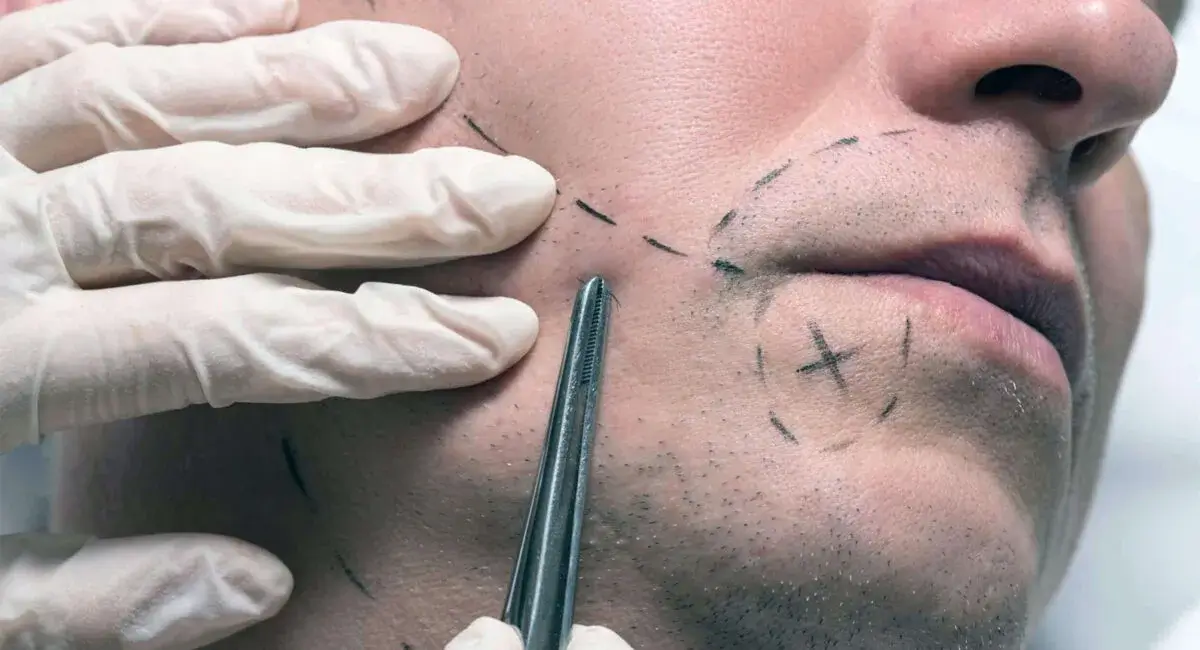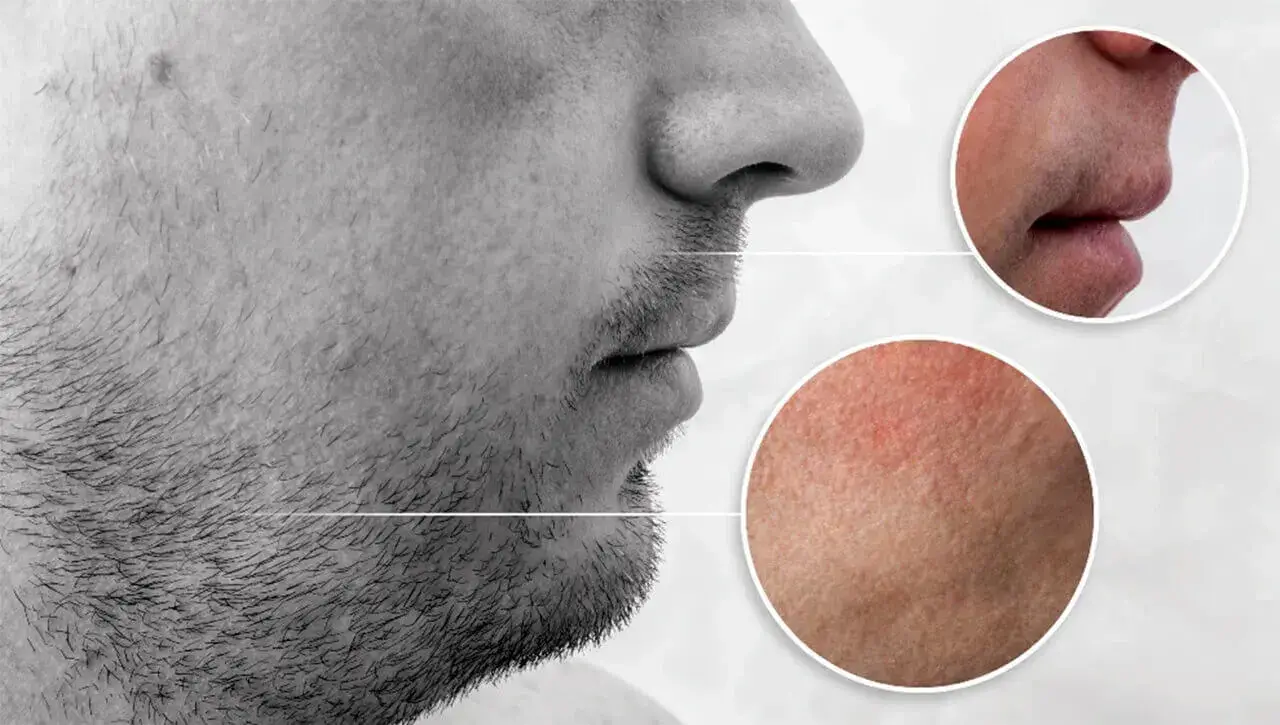Turkey Beard Transplant
At EstheMed Clinic, we understand that facial hair plays a significant role in a man’s identity and confidence. For those struggling with patchy, thin, or absent facial hair, our beard transplant service offers a transformative solution tailored to your needs.
At EstheMed, we offer advanced beard hair transplant procedures that help you achieve the full, thick beard you’ve always desired. Whether you’re dealing with patchy, uneven growth, or have experienced hair loss due to genetics or other factors, a beard transplant can transform your appearance and restore your confidence. Our expert surgeons are highly skilled in the beard transplant procedure, ensuring natural results tailored to your facial features.

Why Choose Beard Transplantation?
Beard transplants are becoming increasingly popular among men seeking to enhance their facial hair. Factors such as genetics, hormonal changes, and scarring can contribute to uneven or sparse beard growth. Our expert team is committed to helping you achieve a fuller, more defined beard that complements your facial features.
Advanced Techniques for Natural Results
We utilize the latest hair transplantation techniques to ensure optimal results:
- FUE (Follicular Unit Extraction): This minimally invasive method involves extracting individual hair follicles from the donor area—usually the back of the head—and transplanting them to the beard area. FUE is preferred for beard transplants due to its precision and minimal scarring.
- DHI (Direct Hair Implantation): DHI is an advanced technique that allows for direct implantation of hair follicles without the need for incisions. This method provides better control over the placement of each hair, ensuring a natural look and feel for your beard.
- Sapphire FUE: Utilizing advanced sapphire blades, this technique enhances the precision of the extraction and implantation process. The reduced trauma to the scalp and beard area promotes faster healing and optimal results.
Comprehensive Care and Support
At EstheMed Clinic, we prioritize your comfort and satisfaction throughout the entire beard transplant process. Our services include:
- Personalized Consultations: Our experienced team conducts thorough assessments to understand your specific goals and expectations.
- Custom Treatment Plans: We create a tailored plan based on your hair type, facial structure, and desired beard style.
- Post-Operative Care: We provide detailed aftercare instructions to ensure a smooth recovery and the best possible results.
Transform Your Look with EstheMed Clinic
A beard transplant can significantly enhance your appearance and boost your self-confidence. At EstheMed Clinic, we pride ourselves on delivering high-quality care and exceptional results, allowing you to embrace a fuller, more stylish beard.
Join the many men who have transformed their look and regained their confidence through our expert beard transplant services. Experience the difference at EstheMed Clinic—where your journey to a stunning beard begins.

beard implants Turkey
To fully appreciate the intricacies of beard transplants, it’s crucial to understand the scientific principles that make this procedure possible. The success of beard transplants relies on the biology of hair growth and the careful manipulation of hair follicles.
Hair Growth Cycle
Hair growth occurs in cycles, consisting of three main phases: anagen (growth), catagen (transition), and telogen (resting). Understanding this cycle is essential for both the timing of the transplant and the expectations for new growth post-procedure.
Donor Hair Selection
The selection of donor hair is critical to the success of a beard transplant. Typically, hair from the back of the scalp is chosen due to its genetic resistance to male pattern baldness. This ensures that the transplanted hair will continue to grow in its new location on the face.
Follicular Unit Extraction (FUE)
FUE is a modern technique used in beard transplants where individual hair follicles are extracted from the donor area. This method minimizes scarring and allows for a quicker recovery time compared to older strip harvesting methods.
Graft Survival
The survival rate of transplanted hair grafts depends on various factors, including the skill of the surgeon, the handling of the grafts, and the recipient site preparation. Proper technique and care during the transplant process are crucial for ensuring a high percentage of successful hair growth.
What is a Beard Transplant?
A beard hair transplant is a surgical procedure where beard grafts (individual hair follicles) are taken from a donor area, usually the back of the scalp, and transplanted into the beard area. This procedure is ideal for those who have thin, patchy, or uneven beards. The beard transplant process typically involves extracting hair follicles using the FUE (Follicular Unit Extraction) method, which is minimally invasive and offers natural-looking results.
The Beard Transplant Procedure: Step by Step
- Consultation: During the initial consultation, our beard surgeon will evaluate your face shape, the quality of your donor hair, and your expectations to create a customized treatment plan.
- Extraction: Using FUE beard transplant techniques, healthy hair follicles are extracted from your beard transplant donor area (usually from the scalp).
- Graft Placement: The extracted beard hair grafts are carefully placed into the beard area to mimic natural growth patterns.
- Recovery: Post-surgery, you’ll experience some swelling and redness, but the recovery time is typically short. Most patients see noticeable results after a few weeks.
Beard Transplant Results: Before and After
Patients often see significant changes within the first few months after the procedure. Beard hair transplant before and after photos highlight the dramatic transformation, with fuller, thicker beards that look and feel completely natural. As your transplanted beard grows, you will enjoy a beard that looks just like your natural hair, providing you with long-lasting, permanent results.
- Beard transplant after 1 week: During the first week, there may be some swelling, but early healing begins.
- Beard transplant after 10 days: The initial scabs will fall off, and the grafts will start to settle into place.
- Beard transplant after 1 month: By this time, hair growth starts to become visible, and your beard will continue to fill out over the next few months.
- Beard transplant before and after: The final results can take several months to fully develop, but the transformation is typically noticeable within 3-6 months.
Beard Hair Transplant Cost and Pricing
The beard hair transplant cost can vary depending on several factors such as the number of grafts needed, the complexity of the procedure, and the clinic’s location. At EstheMed, we offer competitive pricing to ensure that you get the best value for your investment. The beard transplant price is generally more affordable than other cosmetic surgeries, and it provides long-term, permanent results. You can discuss the exact cost during your consultation.
Why Choose EstheMed for Your Beard Transplant?
- Experienced Surgeons: Our beard surgeons are highly skilled in beard hair surgery, ensuring optimal placement of the beard hair grafts for the most natural results.
- FUE Beard Transplant: We use the latest FUE beard transplant techniques, which minimize scarring and provide a smooth recovery process.
- Personalized Care: Each transplant is tailored to your individual needs, ensuring that your beard transplant results are in harmony with your facial features.
- Proven Results: Our beard hair transplant before and after photos showcase the exceptional results our patients achieve.
Frequently Asked Questions
How long does it take to recover from a beard transplant?
- Most patients can return to normal activities within a few days, with full recovery taking about 1-2 weeks.
Is the beard transplant permanent?
- Yes, the results are permanent. The transplanted hairs will grow naturally and require minimal maintenance.
What is the best method for beard transplant?
- The FUE beard transplant is the most advanced and preferred method, providing the least amount of scarring and the best natural-looking results.
How much does a beard transplant cost?
- The cost of a beard transplant depends on several factors, such as the number of grafts needed and the surgeon’s expertise. EstheMed offers affordable pricing for high-quality care.
Achieve the Beard of Your Dreams
A beard transplant can transform the appearance of your facial hair, giving you a fuller, more defined beard. Whether you’re interested in a goatee transplant, full beard transplant, or just improving patchy areas, EstheMed is here to help. Our expert team will guide you through the entire process, from consultation to recovery, to ensure that your beard looks its best.
Contact EstheMed today to schedule your consultation and take the first step toward achieving a fuller, thicker beard with our beard hair transplant surgery. Our team is ready to help you get the beard you’ve always wanted!
Contact us today for a free consultation and discover the highest quality hair transplant services in Turkey.
Airport Transfer
Transfer service with our superior vehicle comfort, our experienced chauffeurs.
Medications
Medications are required during, before and after hair transplantation surgery.
Accommodation
Best all inclusive hotels in Turkey - 4 or 5 - star hotels accommodation.
Aftercare Services
We provide post-transplant care instructions and a help so you get all the guidance you need.
Translators
Our professional translators will be with you from the moment you arrive in Turkey until you return.
Online Consultation
Get instant results with online consulting. Plus it’s Free!
Before Operation, Pre-procedural Advice:








After Operation, Post-procedural Instruction:









Reasons for Considering a Beard Transplant
There are numerous motivations that lead men to explore the option of a beard transplant. Understanding these reasons can help potential candidates determine if this procedure aligns with their personal goals and circumstances.
Genetic Factors
One of the primary reasons men seek beard transplants is due to genetic predisposition. Some individuals naturally have sparse or patchy facial hair growth, which can be attributed to their genetic makeup. This can result in an inability to grow a full beard or create the desired facial hair pattern, despite efforts to stimulate growth through various means.
Age-Related Changes
As men age, they may experience changes in their facial hair growth patterns. Some find that certain areas of their face become less capable of producing thick, consistent hair growth. A beard transplant can help restore a more youthful appearance by filling in areas that have thinned over time.
Scarring and Trauma
Facial scarring from accidents, burns, or previous surgeries can impede hair growth in affected areas. Beard transplants offer a solution for camouflaging these scars by implanting hair follicles directly into the scarred tissue, helping to restore a more natural appearance to the face.
Cultural and Religious Significance
In many cultures and religions, beards hold significant importance. For individuals who value facial hair as part of their cultural or religious identity, the inability to grow a full beard can be particularly distressing. A beard transplant can help these men achieve the desired look that aligns with their beliefs and traditions.
Enhancing Facial Features
Some men opt for beard transplants to enhance their facial features or create a more defined jawline. A well-groomed beard can help balance facial proportions and create a more masculine appearance, which can boost confidence and self-esteem.
Preparing for a Beard Transplant
Proper preparation is key to ensuring the best possible outcome for a beard transplant procedure. This section will outline the steps involved in getting ready for the transplant, from initial consultation to pre-operative care.
Initial Consultation
The first step in the beard transplant journey is a comprehensive consultation with a qualified hair restoration specialist. During this meeting, the surgeon will:
- Assess your facial hair growth patterns
- Discuss your desired outcome
- Evaluate the quality and quantity of donor hair available
- Explain the procedure in detail
- Address any concerns or questions you may have
Medical Evaluation
A thorough medical evaluation is necessary to ensure you’re a suitable candidate for the procedure. This may include:
- Blood tests to check for any underlying health issues
- Review of your medical history
- Discussion of any medications you’re currently taking
Designing Your Beard
Working with your surgeon, you’ll create a plan for your ideal beard shape and density. This involves:
- Marking the areas where hair will be transplanted
- Determining the number of grafts needed
- Discussing the natural direction of hair growth to ensure a realistic appearance
Pre-Operative Instructions
In the weeks leading up to your beard transplant, you’ll receive specific instructions to follow, which may include:
- Avoiding certain medications and supplements that can increase bleeding
- Quitting smoking to improve healing
- Arranging for transportation on the day of the procedure
- Planning for time off work for recovery
Turkey Beard Transplant Procedure
Understanding the step-by-step process of a beard transplant can help alleviate anxiety and set realistic expectations for the day of the procedure. Here’s what typically occurs during a beard transplant surgery:
Anesthesia Administration
The procedure begins with the administration of local anesthesia to both the donor and recipient areas. This ensures that you remain comfortable throughout the surgery while staying awake.
Harvesting the Donor Hair
Using the FUE technique, individual hair follicles are carefully extracted from the donor area, usually the back of the scalp. This process can take several hours, depending on the number of grafts needed.
Preparing the Recipient Site
While the grafts are being harvested, the surgeon prepares the recipient area on your face. This involves creating tiny incisions in the skin where the hair follicles will be implanted, taking care to match the natural direction and angle of hair growth.
Implanting the Grafts
Once the grafts are ready and the recipient site is prepared, the surgeon meticulously implants each hair follicle into the pre-made incisions. This is a delicate process that requires precision and artistic skill to achieve a natural-looking result.
Final Touches
After all the grafts are placed, the surgeon will review their work, making any necessary adjustments to ensure evenness and a natural appearance. The donor and recipient areas are then cleaned and dressed.
Post-Procedure Care and Recovery
The success of a beard transplant greatly depends on proper aftercare and following your surgeon’s instructions diligently. Here’s what you can expect during the recovery period:
Immediate Aftercare
In the first few days following the procedure:
- Keep the transplanted area clean and dry
- Sleep with your head elevated to reduce swelling
- Avoid touching or scratching the recipient area
- Take prescribed medications as directed
Managing Discomfort
Some discomfort is normal and can be managed with:
- Over-the-counter pain relievers
- Cold compresses to reduce swelling
- Gentle care when washing your face
The Shedding Phase
Around 2-3 weeks post-procedure, it’s common for the transplanted hair to shed. This is a normal part of the process and doesn’t indicate failure of the transplant. New growth will begin in the following months.
Long-Term Care
To ensure the best results:
- Avoid direct sunlight on the transplanted area for several weeks
- Gradually reintroduce your normal skincare routine as advised by your surgeon
- Be patient, as full results may take up to a year to become apparent
Expected Results and Timeline
Understanding the timeline for beard transplant results can help manage expectations and ensure patient satisfaction. Here’s what you can typically expect:
Immediate Post-Procedure Appearance
Right after the transplant, the treated area may appear red and swollen, with visible scabs around each transplanted follicle. This is normal and will subside over the next week or two.
The Shedding Phase (2-3 weeks)
As mentioned earlier, the transplanted hair will likely shed around this time. This can be disconcerting but is a natural part of the process as the follicles enter a dormant phase before new growth begins.
Initial Growth (3-4 months)
Around the 3-month mark, you should start to see new hair growth in the transplanted areas. This growth may be patchy or uneven at first.
Continued Improvement (4-8 months)
Over the next few months, hair growth will continue to improve in density and coverage. The new beard hair will begin to blend more naturally with existing facial hair.
Final Results (9-12 months)
By the one-year mark, you should see the full results of your beard transplant. The transplanted hair will have grown to a length where it can be styled and groomed according to your preferences.
Beard implants offer a permanent solution for men seeking to enhance their facial hair appearance. Whether addressing patchy growth, filling in scars, or creating a full beard where none existed before, this procedure can significantly impact one’s self-image and confidence.
As with any cosmetic procedure, it’s crucial to approach beard transplants with realistic expectations and a thorough understanding of the process. By choosing a skilled surgeon, following proper aftercare instructions, and maintaining patience throughout the growth process, you can achieve the beard you’ve always desired.
Remember that while beard transplants can produce remarkable results, they are not a one-size-fits-all solution. Consider all your options, weigh the potential risks and benefits, and make an informed decision based on your personal goals and circumstances.
Ultimately, whether you choose to pursue a beard transplant or explore alternative methods, the journey to your ideal facial hair should be one of self-discovery and empowerment. Embrace the process, and look forward to the confidence that comes with achieving your desired look.
Contact us today for a free consultation and discover the highest quality hair transplant services in Turkey.
We Speak 10 Languages
Some of the languages we speak include:
- English
- English
- English
- Turkish
- German
- French
- Italian
- Dutch
- Russian
- Spanish
- Arabic
- Polish
Our Hair Transplant Experts

Dr. Emre Kaya

Dr. Selin Yılmaz

Dr. Murat Demir

Dr. Ayşe Karadeniz
HAIR TRANSPLANT
Hair Transplant Treatments
Patients from all over the globe go to Turkey for hair transplant Turkey surgery due to its rising popularity in recent years. As EstheMed Clinic, we provide latest hair transplantation methods such as FUE, SAPPHIRE FUE, and DHI. Our surgeon has a lot of training and practice. Surgeons in Turkey often have a great deal of training and practice.



